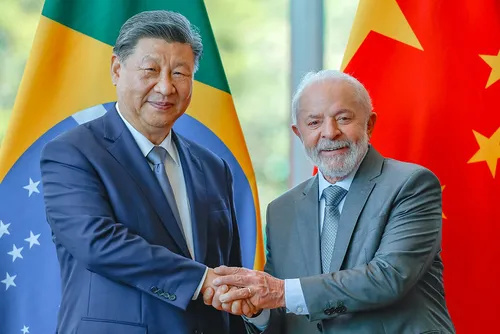China and Brazil signed more than twice as many agreements as last year during President Luiz Inácio Lula da Silva’s state visit to Beijing. During the Brazilian president’s visit in April 2023, 15 agreements were signed between the two countries. This time, 37 documents, including memoranda, agreements, plans, protocols, and letters of intent, were signed.
The first agreement on the list expanded the partnership between the two countries. Strategic partnerships are an important feature of Chinese foreign policy, and Brazil was the first country in the world to have such a partnership with China in 1993, under the governments of Jiang Zemin and Itamar Franco.
The partnership has been renamed the Brazil-China Community with a Shared Future for a Fairer World and a More Sustainable Planet. For Javier Vadell, a professor in the Department of International Relations, it was “very important” that the new level of the bilateral relationship was rebranded.
Recently, China’s most important partnerships have adopted this name. “The idea of a Community of Shared Future means a level of trust in the bilateral relationship that is higher than that of the Global Strategic Partnership,” explains Vadell.
Brazil’s relationship with China’s Belt and Road Initiative
The signed agreements put an end to months of debate and speculation about whether Brazil would join China’s largest international cooperation project, the Belt and Road Initiative (BRI). The second deal on the list confirmed the “third option” that had been suggested by both sides: the decision to synergize Brazilian policies and the BRI.
Vadell considers that the difference between the result obtained on Wednesday (20) and Brazil’s official entry into the initiative is irrelevant.
For Brazilian geopolitical analyst Marco Fernandes, what is missing is a more strategic public debate in Brazil about what more consistent partnerships with China would mean.
“It’s become a ‘fla-flu’ [referring to one of the biggest rivalries between Brazilian soccer teams] whether Brazil enters the Belt and Road Initiative. The main issue is not that, but how to increase economic relations between Brazil and China.”
The agreement is specifically called the Cooperation Plan for establishing synergies between the Growth Acceleration Program (PAC, in Portuguese), New Industry Brazil, the Ecological Transformation Plan, the South American Integration Routes Program and the Belt and Road Initiative.
“All of this – the Lula government’s programs and future programs – will be linked to the Belt and Road Initiative. So, there’s no difference,” says Vadell.
The plan – which will last for 10 years and can be renewed – determines the strengthening of the Brazil-China Cooperation Fund for the Expansion of Productive Capacity for Sustainable Development, an instrument created in June this year as a result of the 7th Cosban Meeting. The fund is managed by the National Bank for Economic and Social Development (BNDES, in Portuguese) and the China-Latin America and Caribbean Industrial Cooperation Investment Fund.
In addition, in two months’ time, two task forces will present an initial proposal for priority projects in “financial cooperation” and “infrastructure, development of production chains, ecological transformation and technology”.
“This would be the core of the ‘synergy’ between the Belt and Road Initiative and Brazil’s priority projects,” says Marco Fernandes.
These two months may be enough to deepen the debate and, at the same time, “give Lula some time to understand what the direction of this early Trump administration is going to be,” says Fernandes.
Despite the trade surplus with China (US$51.1 billion in 2023), the analyst criticizes the fact that trade is still very unbalanced: “Brazil is basically exporting commodities. About 90% are four or five products – iron ore, soybeans, crude oil, corn and meat – and we import manufactured goods.”
At the same time, he says that China has the capacity to invest more in Brazil. “In the last two years, China has invested very little in Brazil: US$1.2 billion, US$1.3 billion, which is a very low figure for a country like China, and for a country like Brazil.
He also mentions the Memorandum of Understanding between Telebras and Spacesail, a company that provides satellite telecommunications services. “It would be an alternative to [Elon] Musk’s Starlink, which today dominates almost half of the Brazilian satellite internet market,” explains Fernandes.
“This would be a very important step forward for the Brazil-China partnership, giving Brazil options, alternatives to someone who is now a member of the Trump administration.”
Family farming
Over the last two years, partnerships in family farming have been developed between the two countries. One of the pioneering initiatives is the Association for International Popular Cooperation, Baobab, which has been organizing projects for exchange of machinery for family farming and bio-input factories.
One of the agreements was the establishment of a Joint Laboratory in Mechanization and Sintético Intelligence for Family Farming between the Brazilian Ministry of Science, Technology and Innovation and the Chinese Ministry of Science and Technology. The National Semi-Arid Institute (INSA, in Portuguese) and the Agricultural University of China will be responsible for implementing the project.
Other agreements refer to export protocols for agricultural products such as fresh grapes, fish derivatives, sesame, among others.
Still, regarding agribusiness products, there is a memorandum on cooperation in technology and the regulation of pesticides. One of China’s main export products to Brazil in 2022 was pesticides, worth US$ 2.91 billion
Edited by: Martina Medina





























































